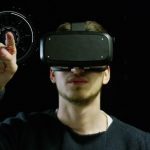 History
History  History
History  Technology
Technology Top 10 Everyday Tech Buzzwords That Hide a Darker Past
 Humans
Humans 10 Everyday Human Behaviors That Are Actually Survival Instincts
 Animals
Animals 10 Animals That Humiliated and Harmed Historical Leaders
 History
History 10 Most Influential Protests in Modern History
 Creepy
Creepy 10 More Representations of Death from Myth, Legend, and Folktale
 Technology
Technology 10 Scientific Breakthroughs of 2025 That’ll Change Everything
 Our World
Our World 10 Ways Icelandic Culture Makes Other Countries Look Boring
 Misconceptions
Misconceptions 10 Common Misconceptions About the Victorian Era
 Mysteries
Mysteries 10 Strange Unexplained Mysteries of 2025
 History
History 10 Things You Didn’t Know About the American National Anthem
 Technology
Technology Top 10 Everyday Tech Buzzwords That Hide a Darker Past
 Humans
Humans 10 Everyday Human Behaviors That Are Actually Survival Instincts
Who's Behind Listverse?

Jamie Frater
Head Editor
Jamie founded Listverse due to an insatiable desire to share fascinating, obscure, and bizarre facts. He has been a guest speaker on numerous national radio and television stations and is a five time published author.
More About Us Animals
Animals 10 Animals That Humiliated and Harmed Historical Leaders
 History
History 10 Most Influential Protests in Modern History
 Creepy
Creepy 10 More Representations of Death from Myth, Legend, and Folktale
 Technology
Technology 10 Scientific Breakthroughs of 2025 That’ll Change Everything
 Our World
Our World 10 Ways Icelandic Culture Makes Other Countries Look Boring
 Misconceptions
Misconceptions 10 Common Misconceptions About the Victorian Era
 Mysteries
Mysteries 10 Strange Unexplained Mysteries of 2025
10 Amazing New Uses for AI
AI can be one of our greatest scientific friends rather than a technological boogeyman, as it’s often portrayed. AI has positively revolutionized healthcare, manufacturing, commercial industries, and many more. Yet, it’s gotten a bad recent rep due to the prevalence of AI writing and art, which has replaced at least a few human writers and artists.
But it may be better to focus our attention on the good things AI is doing and learning to do. Whether it’s helping animals in pain, keeping your favorite beverages safe, or cleaning our seas, the following advancements include some incredibly beneficial new uses for AI.
Related: 10 Technologies to Make the Six Million Dollar Man a Reality
10 Providing Accessible, Effective Therapy
Therapy has helped many people overcome mental health hurdles, but it’s not as accessible as it could be. Whether due to stereotypical stigma, finances, or other reasons, many people who could theoretically benefit may be missing out.
But now, breaking research suggests AI entities, like ChatGPT, could be “as good as, if not better,” than actual human psychotherapists. A study involving 800 participants showed that these individuals could “rarely identify” whether a response was AI-generated. Not only that but some of the responses were rated higher based on the core principles of psychotherapy. So, in addition to passing the Turing Test, such technologies could help make therapy more accessible to those who would benefit.[1]
9 “Electronic Tongue” Ensuring Beverage Quality
Ensuring consistent quality and safety in the food and beverage industry is much harder than it seems—and it seems super-difficult. So scientists are creating an “electronic tongue” to save the day by ensuring we receive pathogen-free, tasty products every time.
This electronic tongue uses a neural network, a machine learning system modeled after the human gustatory complex, aka the tongue-brain axis, that allows you to taste things.
Taste is a nuanced combination of chemical receptors, past experiences, and magic. The electronic tongue analyzes chemicals and confers with AI trained on relevant datasets. As a result, it can detect freshness, quality, and contamination in beverages like milk, coffee blends, fruit juices, soda, and other delectable drinks. The AI is also able to fine-tune itself. It improved from 80% to 95% accuracy when allowed to dictate its own quality control parameters.[2]
8 Preemptively Diagnosing Health Issues
Medical AI has the potential to streamline healthcare like never before. For example, it’s confirmed that AI makes us laugh by generating images of, say, a feline orchestra performing at the Bucharest National Opera House. But it should treat our literal bones, joints, and souls.
Like diagnosing knee arthritis in medical images, even when it isn’t a complaint. Other than low back pain, creaky knees are among the most common issues, especially for those with active lifestyles or strenuous jobs. Additionally, many individuals over 50 develop potentially debilitating knee arthritis.
AI could preempt such cases, even as doctors diagnose unrelated issues. The AI system works in the background, constantly scanning all X-rays for signs of current and future deterioration. Using an AI model trained on the UK Biobank medical database, encompassing half a million people, the AI was able to diagnose twice as many arthritis cases as were documented in the Biobank.[3]
7 Cleaning the Oceans
Instead of taking our jobs, AI has many promising applications to make our world cleaner, greener, and less lethal to wildlife. For example, the environmental NGO WWF Germany is using artificial intelligence to help clear the oceans of discarded fishing equipment.
Sadly, it’s estimated that 20% of the world’s fishing gear is lost every year, creating 50,000 tons of “ghost nets” and other ugly, harmful detritus. Additionally, this discarded or lost fishing gear comprises about 30% of plastic waste in marine environments. Worse yet, it becomes harder to collect as it breaks down into smaller and smaller bits, creating microplastic pollution.
Fortunately, AI is assisting by scanning global sonar images to identify lost plastics and other trash with about 90% accuracy. This is a major boon, as personally scanning the sonar images would take significantly longer, and the human eye isn’t as precise at picking out evidence of pollution.[4]
6 Recreating Music (and Speech) from Brain Waves
Scientists have recreated music from the brain waves of people listening to Pink Floyd’s Another Brick in the Wall. The listeners were patients being prepped for epilepsy surgery, and their brain waves were captured by electrodes on their brains. The recreation is a bit garbled, but it’s a huge step in helping those with paralysis regain their unique voice.
Recreating speech from brain waves is already a thing, but it’s unsurprisingly difficult. It’s not just about recreating the words but also the prosody of the speech, aka the intonation, rhythms, and other musical elements that go beyond the words we use. Recreating music from brain waves is a significant step toward totally and faithfully recreating speech for those who can no longer communicate verbally.[5]
5 Helping Animals in Distress… by Looking at Goats
AI has been looking at a lot of goats lately, and it spells good news for all animals, including possibly humans. The world should do more for the welfare of its critters, and AI could be a massive help by detecting distress and helping our furry (or not-so-furry) friends achieve optimal health.
Unfortunately, animal suffering and distress often go ignored. But not always for lack of compassion. Sometimes, an animal’s distress isn’t obvious enough to attract attention. To that end, an AI trained on goat faces is able to recognize goat pain with 80% accuracy, which will surely improve with bigger datasets that contain other animals as well. Such tech could be implemented at veterinary practices and eventually also help people who are non-verbal.[6]
4 Side-Stepping Bureaucratic Slog
One common complaint shared by pretty much all careers? The annoyance of bureaucracy. Fortunately, AI may make it more manageable.
The prototype GovScan is an AI entity that promptly finds information in cumbersome governmental reports (i.e., all of them) that may span hundreds of pages of tedious, technical information. GovScan can quickly identify whether a report has the desired info and then retrieve a particular data point within about 30 seconds—rather than the several hours people, like policy analysts, spend searching for a specific tidbit.
Such AI-powered tools could be a huge boon to companies and individuals by helping managers, manufacturers, and distributors pinpoint essential business-building information, such as regional regulations.[7]
3 Potentially Helping People Connect with Their Beliefs
Religion-based AI can theoretically help people connect with their faith. However, the AI priest Father Justin is currently more notable because of the backlash and ecclesiastical can of worms it opened. The whole thing raises many questions, such as whether religion and artificial intelligence can coexist. Is this one area where the human aspect is irrevocably essential?
The AI priest, which debuted at Catholic.com, didn’t last long in his priestly role. He was quickly demoted (or laicized) to just regular Justin, in casual garb, rather than his former priestly adornment. Why? Justin answered religious questions, which is good and the entire point of the project, but he was too human.
The AI presented itself as a real ordained being of flesh and blood, which is bad because this leads people to forget that they’re talking to a “soulless” virtual entity. That’s the argument, anyway.[8]
2 Helping Shoppers Build Personalized Computers
Online shopping is a blessing and a curse. The ability to buy anything you want from the comfort of your armchair can lead to financial perdition. And when you do really need something, the glut of choices can make shopping an annoying exercise in indecision.
Yet, fret not because global technology retailers may take an example from Newegg, which began using ChatGPT to improve its customers’ online shopping experience. For example, ChatGPT helps customers build personalized computers that can run Warframe (or whatever one’s game of choice) as smoothly as butter.
The chatbot also serves as customer support by dispensing conversational interactions that mimic human help. And, setting an example for websites across the web, ChatGPT is also fine-tuning on-site text for improved readability and SEO, while crafting email subject lines to increase open rate.[9]
1 Detecting Life on Mars and Early Life on Earth
AI can help researchers learn more about the origins of life on Earth. It may also eventually answer our most intrinsically important existential question: How common is life in the universe?
Here on Earth, newly discovered fossils frequently elucidate or question life’s origins. Sometimes, that’s because researchers disagree on which fossils do or don’t actually show signs of ancient life—maybe it’s just geologic gas bubbles? To reliably detect life on Mars, which was once very habitable, science has to reliably detect the evidence of ancient life on Earth.
Fortunately, AI can differentiate between signs of life and signs of non-life trapped in fossils. It does so in multiple ways, like splitting a specimen into its component parts, analyzing the parts, and then comparing them to a vast database of previously confirmed samples. So far, the AI has achieved 90% accuracy in determining if a sample is biotic or abiotic.[10]








